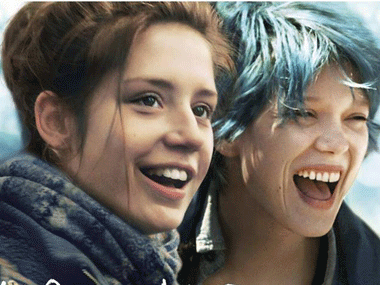
Senior staff writer Warren Zhang says the best parts of Blue Is the Warmest Color aren’t even the sex scenes.
Most movies communicate in narrative shorthand that strips out the inessential details to more efficiently dole out its plot. When you see empty plates on a table, the movie’s telling you that dinner has happened. You don’t need to see them eating; you just know that these actors have already filled their guts.
Blue Is the Warmest Color, on the other hand, is an epic built almost entirely out of these cut moments. From the very first shot, in which the main character awkwardly chases after an unexpectedly early bus, the film finds microscopic, easily missed moments that, when combined, create one of the most fully realized character portraits of all time.
The greatest trick director Abdellatif Kechiche (Black Venus) pulls off is in rendering lead character Adèle (an arresting performance from Adèle Exarchopoulos of I Used to Be Darker) not larger than life but as a real person within our own lives.
The movie doesn’t shy away from filming its actors in a less flattering light. There’s virtually no cinematic gloss to these characters, which is to say Blue Is the Warmest Color contains a lot of close-ups and a lot of them are filled with bodily fluids — snot, tears, spit and … others.
Yet the characters, especially Adèle, are never less than compelling and radiant. It’s a weird paradox at the center of the film — everything is so grounded and so unglamorous, yet all the images are so captivating and beautiful, the use of color so precise.
Everything flows organically from one moment to the next with almost no artifice whatsoever. Exarchopoulos finds herself in an unsatisfying relationship with a high school classmate. She catches a fleeting glance of Léa Seydoux’s (Sister) character, Emma, and it’s basically love at first sight. Eventually, the two start a serious relationship as years fly by, and Seydoux tries to sell her artwork and further her career while Exarchopoulos becomes an elementary school teacher.
This is one of the rare movies that almost demands a sequel. The film ends on a note of unconsummated hope, instead of anything remotely concrete. The performances are so lived-in and natural and the story so effortless that you could easily imagine Kechiche and Exarchopoulos knocking another one out of the park.
Blue Is the Warmest Color is not perfect. While I would happily watch a five-hour cut of this movie, the now-infamous sex scenes are a bit gratuitous. You can intellectually justify and appreciate why Kechiche would want to film his lesbian characters making love at the same deliberate pace the rest of the film moves.
The immediate gut reaction? Not so high-minded. You get the sense that Exarchopoulos and Seydoux aren’t graphically eating each other out so as to more intimately document another aspect of their lives but rather because the director felt like he could get away with it.
But despite the occasional misstep, Blue Is the Warmest Color is never less than a vital and awesomely vivid three-hour trip. As much press as the very NC-17 scenes have gotten, the rest of Blue Is the Warmest Color is where its naked, beating heart lies.



